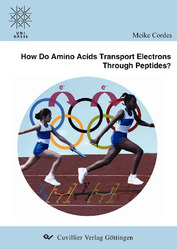| Departments | |
|---|---|
| Book Series (96) |
1378
|
| Nachhaltigkeit |
3
|
| Gesundheitswesen |
1
|
| Humanities |
2363
|
| Natural Sciences |
5406
|
| Mathematics | 229 |
| Informatics | 319 |
| Physics | 980 |
| Chemistry | 1363 |
| Geosciences | 131 |
| Human medicine | 243 |
| Stomatology | 10 |
| Veterinary medicine | 108 |
| Pharmacy | 147 |
| Biology | 835 |
| Biochemistry, molecular biology, gene technology | 121 |
| Biophysics | 25 |
| Domestic and nutritional science | 45 |
| Agricultural science | 1004 |
| Forest science | 201 |
| Horticultural science | 20 |
| Environmental research, ecology and landscape conservation | 148 |
| Engineering |
1791
|
| Common |
98
|
|
Leitlinien Unfallchirurgie
5. Auflage bestellen |
|
Advanced Search
How Do Amino Acids Transport Electrons Through Peptides? (English shop)
Meike Cordes (Author)Preview
Table of Contents, Datei (36 KB)
Extract, Datei (180 KB)
A peptide model was designed, which allows the investigation of amino acid side chain participation in ET through peptides. Aromatic amino acids function as oxidizable spectroscopic sensors for the direct observation of charged intermediates during the ET process. Tyrosine as electron donor, situated at the N-terminus of the peptide, provides driving force for the ET process and is irreversibly oxidized to a long-lived phenoxyl radical with a sharp absorption band. Two methoxysubstituted phenylalanine derivatives were chosen as additional spectroscopic sensors, yielding oxidized transients with different absorption spectra. They were synthesized in their enantiopure form and investigated with respect to their electrochemical and spectroscopical properties. In the peptide model, they function as C-terminal electron acceptor precursor and central relay, separated from each other and the donor by a proline matrix. The electron acceptor can be generated by laser irradiation of an injection unit, containing a tbutyl ketone as chromophore. Transient absorption spectra recorded 40 ns after the laser flash were used for the examination of intramolecular ET efficiencies between the redox sites. The observation of intramolecular ET from the N-terminus to the C-terminus of a nonapeptide, which consisted of two triproline spacers and the three spectroscopic sensors was possible. This peptide showed a well-defined polyproline II helical structure, leading to a donor/acceptor separation of 20 Å. The aromatic relay, functioning as spectroscopic sensor for the detection of oxidized intermediates in donor to acceptor ET, could be exchanged by a number of different amino acids, without changing the overall structure of the peptide. Thus, the peptide model allowed us to determine the influence of the central amino acid – separated from both, donor and acceptor, by 10 Å – on ET. The simultaneous occurence of electron acceptor, oxidized donor and oxidized relay could be detected in one case, proving that the charge resides on the relay site during ET. Efficient ET across the 20 Å distance in our model peptides was only possible within 40 ns, if an oxidizable amino acid side chain was present inside the matrix. This side chain functioned as a stepping stone in ET, with the charge residing on it, forming a chemical intermediate. Thus, electron hopping via aromatic amino acid side chains was proven to allow distal (20 Å) ET transfer in peptides within 40 ns whereas single-step superexchange ET did not take place within 40 ns in peptides of similar structure. The rate of intramolacular electron hopping between electron acceptor and electron donor was determined to 5 – 7 ∙106 s-1. In the peptide containing three spectroscopic sensors, the relative intensities of all signals could be used to conclude on the ratio of rate constants in the consecutive ET reaction, leading to a five times faster rate constant for donor to relay, than for relay to acceptor ET. This is consistent with the differences in driving force for the two reactions.
| ISBN-13 (Printausgabe) | 3867275823 |
| ISBN-13 (Hard Copy) | 9783867275828 |
| ISBN-13 (eBook) | 9783736925823 |
| Final Book Format | A5 |
| Language | English |
| Page Number | 158 |
| Edition | 1 |
| Volume | 0 |
| Publication Place | Göttingen |
| Place of Dissertation | Basel |
| Publication Date | 2008-05-07 |
| General Categorization | Dissertation |
| Departments |
Chemistry
|
| Keywords | Aromatic amino acids, peptide, spectroscopic sensors |








